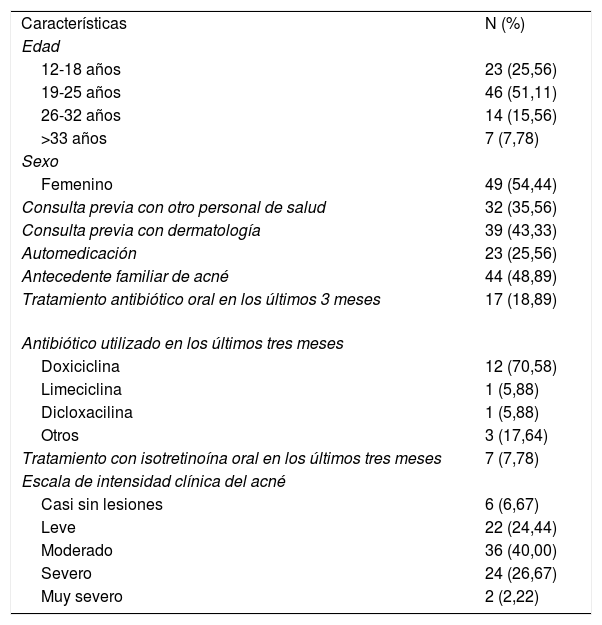El acné es uno de los motivos de consulta más frecuentes en dermatología. Afecta a la mayoría de los adolescentes y trae consecuencias psicosociales que alteran su calidad de vida. Dentro de los aspectos fisiopatológicos se encuentra la colonización por el Cutibacterium acnes (C. acnes) del cual se han descrito 6 filotipos (IA1, IA2, IB, IC, II y III) relacionados con su potencial inflamatorio.
ObjetivoIdentificar los filotipos de C. acnes en lesiones de pacientes con acné que consultaron al Servicio de Dermatología del Hospital de San José, Bogotá, Colombia.
Materiales y métodosSe recolectaron 90 muestras de pacientes con acné que presentaban pústulas. La bacteria fue identificada en cultivo mediante condiciones de anaerobiosis. Las cepas aisladas fueron sometidas a pruebas de sensibilidad antibiótica y posteriormente procesadas y analizadas mediante Microflex LT MALDI-TOF.
ResultadosEl 57,78% de los aislamientos correspondieron a los géneros Propionibacterium yCutibacterium; de estos, el 65,38% fueron C. acnes, tipificados mediante espectrometría de masas. Los filotipos encontrados fueron IA1, IA2, IB y II en 5,88%, 85,29%, 2,94% y 5,88% respectivamente.
ConclusionesEl filotipo IA2 fue el más frecuentemente identificado, resultado que difiere de datos reportados en estudios no latinoamericanos en los que el IA1 es el predominante, siendo este un hallazgo relevante que abre nuevos interrogantes sobre el comportamiento del C. acnes en diferentes poblaciones. Se reporta también la resistencia antibiótica global y por filotipos a los cuatro antibióticos más utilizados en la práctica clínica, encontrando mayor resistencia a eritromicina, seguido de clindamicina, y en menor proporción a doxiciclina y tetraciclina.
Acne is one of the most common reasons for consultation in dermatology. It affects the most adolescents and brings psychosocial consequences that alter their quality of life. Among the pathophysiological aspects is the colonization by Cutibacterium acnes (C. acnes) of which currently have been described 6 phylotypes (IA1, IA2, IB, IC, II, and III) related to their inflammatory potential.
ObjectiveTo identify the phylotypes of C. acnes in the lesions of patients with acne who consulted the Dermatology Department at Hospital San José, Bogotá, Colombia.
Methods and materialsA 90 samples of acne patients pustules were collected. The bacterium was identified in culture by anaerobic conditions. The isolates where subjected to antibiotic sensitivity tests and subsequently processed and analysed using Microflex™ LT MALDI-TOF.
Result57.78% of the isolates corresponded to the genera Propionibacterium and Cutibacterium; of these, 65.38% were C. acnes, typified by mass spectrometry. The phylotypes found were of type IA1, IA2, IB, and II in 5.88%, 85.29%, 2.94%, and 5.88%, respectively.
ConclusionsThe phylotype IA2 was the most frequently identified, a result that differs from data reported in non-Latin American studies in which the IA1 is the predominant, this relevant finding opens new questions about the behavior of C. acne in different populations. It also reports the global antibiotic resistance to the phylotypes to the four antibiotics most commonly used in clinical practice, finding greater resistance to erythromycin, followed by clindamycin, and in a lesser proportion to doxycycline and tetracycline.
Artículo
Comprando el artículo el PDF del mismo podrá ser descargado
Precio 19,34 €
Comprar ahora












